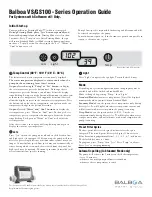
ERQ125~250A7W1B
Inverter condensing unit
4PW51323-1C – 2018.04
Installation manual
7
7.
L
EAK
TEST
AND
VACUUM
DRYING
The units were checked for leaks by the manufacturer.
After connecting the field piping, perform the following inspections.
1
Preparations
Referring to
, connect a nitrogen tank, a cooling tank,
and a vacuum pump to the outdoor unit and perform the
airtightness test and the vacuum drying. The stop valve and
valves A and B in
should be open and closed as shown
in the table below when performing the airtightness test and
vacuum drying.
2
Airtightness test and vacuum drying
Airtightness test:
Pressurize the liquid and gas pipes to 4.0 MPa (40 bar) (do not
pressurize more than 4.0 MPa (40 bar)). If the pressure does not
drop within 24 hours, the system passes the test. If the pressure
drops, check where the nitrogen leaks from.
Vacuum drying: Use a vacuum pump which can evacuate to
–100.7 kPa (5 Torr, –755 mm Hg)
1.
Evacuate the system from the liquid and gas pipes by using a
vacuum pump for more than 2 hours and bring the system to
–100.7 kPa. After keeping the system under that condition for
more than 1 hour, check if the vacuum gauge rises or not. If it
rises, the system may either contain moisture inside or have
leaks.
2.
Following should be executed if there is a possibility of moisture
remaining inside the pipe (if piping work is carried out during the
raining season or over a long period of time, rainwater may enter
the pipe during work).
After evacuating the system for 2 hours, pressurize the system
to 0.05 MPa (vacuum break) with nitrogen gas and evacuate the
system again using the vacuum pump for 1 hour to –100.7 kPa
(vacuum drying). If the system can not be evacuated to
–100.7 kPa within 2 hours, repeat the operation of vacuum
break and vacuum drying.
Then, after leaving the system in vacuum for 1 hour, confirm that
the vacuum gauge does not rise.
8.
F
IELD
WIRING
1
Pressure reducing valve
2
Nitrogen
3
Measuring instrument
4
Tank (siphon system)
5
Vacuum pump
6
Charge hose
7
Service port for adding refrigerant
8
Liquid line stop valve
9
Gas line stop valve
10
Outdoor unit
11
To air handling unit
12
Stop valve service port
13
Dotted lines represent on site piping
14
Valve B
15
Valve C
16
Valve A
State
of the valves A and B
and the stop valve
Valve
A
Valve
B
Valve
C
Liquid
side
stop
valve
Gas
side
stop
valve
Performing the
airtightness test and
vacuum drying
(Valve A must always be
shut. Otherwise the
refrigerant in the unit will
pour out.)
Close
Open
Open
Close
Close
NOTE
Make sure to perform airtightness test
and vacuum drying using the service
ports of the stop valves of the liquid
side and of the gas side. (For the
service port location, refer to the
"Caution" label attached on the front
panel of the outdoor unit.)
See
for details
on handling the stop valve.
To prevent entry of any contamination and to
prevent insufficient pressure resistance, always
use the special tools dedicated for working with
R410A refrigerant.
NOTE
Make sure to use nitrogen gas.
All field wiring and components must be installed by a
licensed electrician and must comply with relevant local
and national regulations.
The field wiring must be carried out in accordance with the
wiring diagrams and the instructions given below.
Be sure to use a dedicated power circuit. Never use a
power supply shared by another appliance. This can lead
to electric shock or fire.
Be sure to install an earth leakage circuit breaker.
(Because this unit uses an inverter, install an earth leakage
circuit breaker that is capable of handling high harmonics
in order to prevent malfunctioning of the earth leakage
breaker itself.)
Do not operate until refrigerant piping work is completed.
(If operated before completion of the piping work, the
compressor may break down.)
Never remove a thermistor, sensor, etc., when connecting
power wiring and transmission wiring.
(If operated without thermistor, sensor, etc., the
compressor may break down.)
The reversed phase protection detector of this product only
functions when the product starts up. Consequently,
reversed phase detection is not performed during normal
operation of the product.
The reversed phase protection detector is designed to stop
the product in the event of an abnormality when the
product is started up.
Replace two of the three phases (L1, L2, and L3) during
reverse-phase protection circuit operation.
If the possibility of reversed phase exists after a
momentary blackout and the power goes on and off while
the product is operating, attach a reversed phase
protection circuit locally. Running the product in reversed
phase can break the compressor and other parts.
Means for disconnection must be incorporated in the field
wiring in accordance with the wiring rules.
(An all-pole disconnection switch must be available on the
unit.)
4PWEN51323-1C_2018_04.book Page 7 Thursday, May 31, 2018 9:12 PM












































